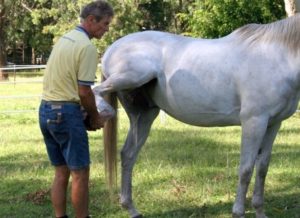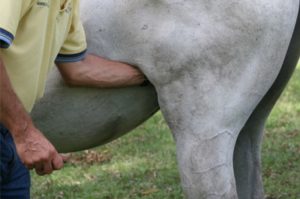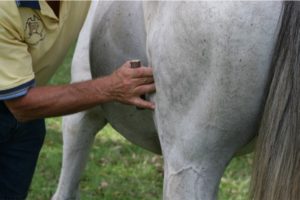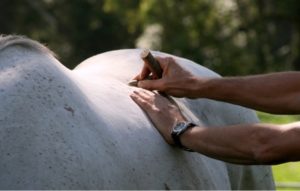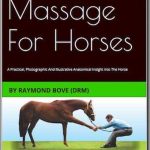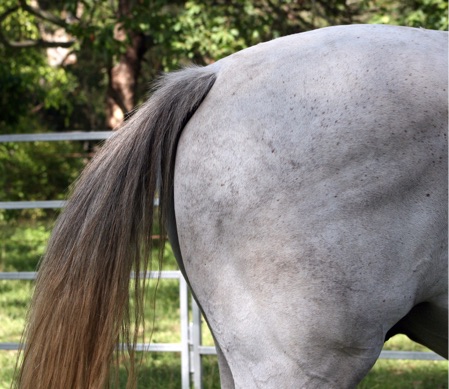
Horses get their power from the back-end. So when a horse has a sore back there will, 99 times out of a 100, be some muscle tension/stress in the horses hindquarters which are the gluteal muscles, the hamstrings and all the connective tissue (fascia) involved.
The section between the hip and thigh bones, a big player in free movement of the back- end and assisting the amount of power the horse can produce.
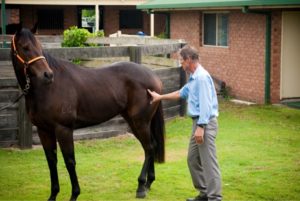
As in the picture above, when you hit the right spot this is the reaction you get. This is a simple single finger pressure where I can incorporate the use of a compression and sliding friction simultaneously. You can see that the gelding feels my touch and pressure as he turns to look at me and picks his foot up off the ground. I tend to focus a bit on the lower part of the middle gluteal muscle because it comes off the tuber coxae and inserts on the thigh bone. The muscle is involved with stabilization of the back end. Remember that all the work you do is highly beneficial in the stabilization of the horse’s framework or skeleton. One side always has more tension than the other. Many horses are a bit all over the place with the muscle stress they carry and live with.
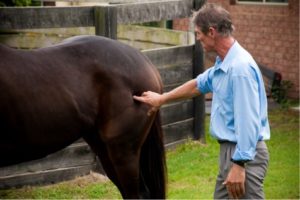
Here I am on the middle-gluteal muscle. A deeper muscle involved with the back-end. The section between the hip and thigh bones, a big player in free movement of the back- end and assisting the amount of power the horse can produce.
There is a lot of fascia over the horse’s hindquarter. When there is too much contraction it places a lot of stress on the nerve branches in and under the gluteal muscles and gluteal fascia. The best example of these blocked nerves is the dorsal branches of sacral nerves.

The most effective way to release a blocked or pinched nerve branch(s) is to apply sliding cross-fibre finger frictions using all your fingers as I am doing in the photo above and over the page. You can apply a lot of pressure here and build it up as you go. The release of fascia is the best way to release a blocked nerve that is trapped in muscle fibres. The horse will push into your pressure. They cannot tell us exactly where ‘that tight spot’ is but they will turn and look at you as if to say “ yes……that’s the spot “ and push into it. You will find there are times when you’re giving it all you’ve got and this horse will still turn his head around and look at you as if to say “thanks”. It’s quite remarkable really. It’s like they have been waiting for someone to come along and do this for them.
This is by far the best method to utilize to release the dorsal branches of the sacral nerves. I persevere with this issue and repeat this several times, slightly changing the angle of my fingers and when the fascia has softened up enough you can see them let go, and quite often it can be more than one sacral nerve. This is normally caused by a matter of balance abnormalities here and there and when released that is a big part of the problem solved. Then you can get on with your work and keep going. However, there are horses, which may be competitive horses of some sort, who are still reasonably sound but sometimes the owner/trainer just cannot get the horse right.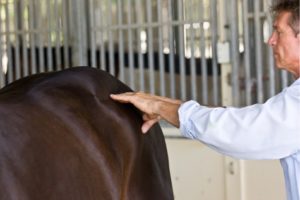
This is where a problem can occur, like nerve entrapment. Once this sort of weakness develops in the backend it can create other problems. When they are like this it can take a change of routine to let things settle or not to aggravate the weakness. I have seen this on several occasions. The entrapment of sacral nerves is quite common. When I use the cross-fibre technique with a lot of pressure they push in as well and to see the nerve branch jump out through the gluteal fascia or release is a satisfying feeling. You have to do the sliding cross fibres a few times with a bit of oomph as well.
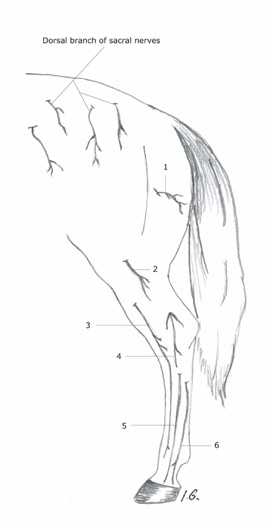
Hindlimb nerves
1 Caudal cutaneous femoral n. – from 3 – sensory to skin
2 Lateral cutaneous sural n. – from 3 – sensory to skin
3 Superficial peroneal n. – motor to lateral digital extensor m. sensory to skin of leg,
hock and metatarsus
4 Caudal cutaneous sural n. – from 10 – sensory to skin
5 Lateral dorsal metatarsal n. sensory to fetlock, pastern and laminar corium
6 Lateral plantar n. – sensory to lateral aspect of digit
Horses can build up tension around the stifle and sometimes there may be a problem in the groin area or on the inside of the thigh bone. You’ve got to take care when you go in here but it may be the source of a problem.
I pick the leg up to see how much movement is possible with the hip joint.
Working over the back-end of the horses requires thorough examination.
